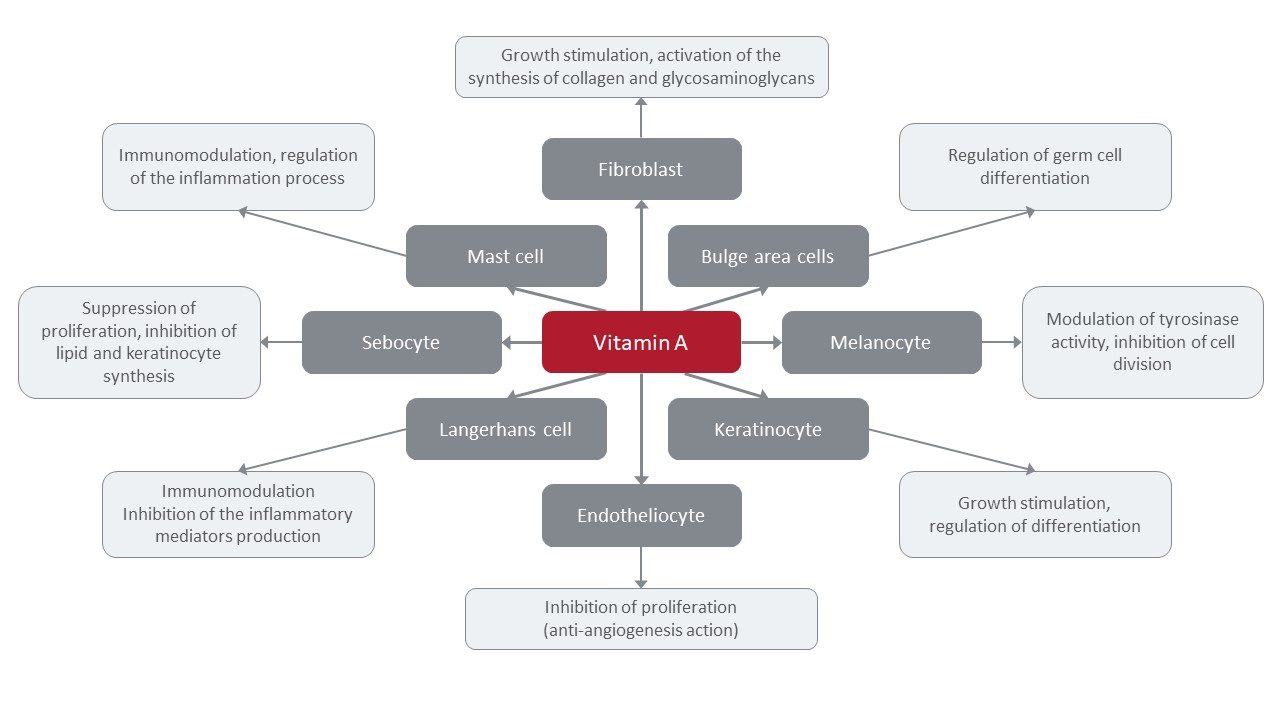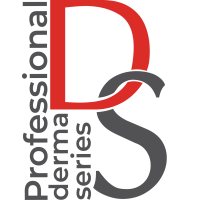- Acne and hyperkeratosis
- Hyperpigmentation
- Age-related changes
The effectiveness of retinol in correcting major aesthetic skin problems is undeniable. What about safety?
Everything is fine with it too, if you follow the rules of application and use the latest generation of retinoids, namely the HPR retinoid.
How does retinol work?
Retinol is a form of vitamin A and a powerful antioxidant. Due to its small molecular size and lipophilicity, retinol is characterized by high bioavailability, it overcomes the lipid barrier of the skin and penetrates the epidermis. In the cell, retinol is metabolized to retinal, retinoic acid, or deposited as an ester.
Retinol stimulates active cell division of the stratum basale layer of the epidermis, accelerates cell regeneration. In addition, it affects not only keratinocytes, but also deeper dermal structures – fibroblasts, melanocytes, which are responsible for skin elasticity and pigmentation uniformity. Enhances the production of its own collagen, elastin, lipids and hyaluronic acid.

On the membrane of keratocytes and fibroblasts, there are special RAR receptors that are tropic only for retinoic acid. Other forms of retinol, due to a cascade of reactions, are able to turn into retinoic acid and give an appropriate response from skin cells, which is characteristic of vitamin A.
What are the forms of retinol?
Retinol itself is unstable to the external environment and easily decomposes, therefore, its various derivatives, retinoids, are used in cosmetics.
Retinoids are natural or synthetic compounds that exhibit similar effects to retinol. Out of the over 4,000 retinoids that have been studied, only a few compounds have reached the stage of clinical use. For example:
Retinal or Retinaldehyde – the modern form of vitamin A, exceeds the power of ordinary retinol by 10 times. It acts much softer, promotes moisture retention in cells, fights dryness and flaking, and does not cause photosensitivity. It has good efficiency at a concentration of 0.025-0.05%. This is an unstable form of vitamin A, so retinaldehyde is rarely found in cosmetics.
Retinyl acetate and Retinyl Palmitate are retinol esters. Retinyl palmitate – a natural derivative of vitamin A, is synthesized in the body from food; retinyl acetate – a salt of acetic acid, is not synthesized in the body naturally. They have the mildest effect compared to other retinoids. Also, they increase the production of hyaluronic acid, improve skin texture, smooth it out and soften it. They are more stable than retinaldehyde, but they do not penetrate well through the cell membrane and act on the surface (healing, scarring).
Tretinoin (transretinoic acid/ Retin-A) is the most action-powerful retinoid. It is used more in pharmaceutical and professional products to combat acne, hyperkeratosis and hyperpigmentation. It has a fairly high irritant potential and is used for medical purposes for a limited amount of time. Prescription form of retinoids.
Tazarotene is also one of the strongest retinoids and is very irritating to the skin. It is prescribed for patients with thick oily skin with acne (low concentration) or psoriasis (high concentration). Prescription form of retinoids.
Isotretinoin is an effective retinoid for treating moderate or severe acne. It cleanses pores, normalizes the production of sebum, and stops the growth of bacteria. In the first weeks of treatment, it can cause a strong deterioration in the skin condition, which is replaced by its restoration. Prescription form of retinoids.
Acitretin and Etretinate are prescribed for various types of psoriasis and keratinization disorders. They slow down the growth of cells in the outer layers of the skin, stabilize the cellular structure, fight against lumps and flaking.
Retinyl Retinoate is a hybrid of retinol and retinoic acid. In terms of efficiency and activity, it is comparable to retinoic acid, but devoid of its side effects. Upon contact with the skin, it “breaks” into two molecules: retinoic acid immediately affects the receptors sensitive to the component, and retinol is released and gradually converted into retinoic acid, so it has a softer influence on the skin. Retinyl retinoate does not increase skin photosensitivity, which makes it possible to use this form of retinol during the day.
Hydroxypinacolone Retinoate (or Granactive Retinoid HPR) is the latest generation of retinoid, retinoic acid ester, that outperforms all OTC forms. And the important thing is that it does not have negative side effects that are inherent in the active derivatives of retinoic acid.
Retinoid HPR binds directly to retinoid receptors on skin cells, meaning it does not need to be converted to retinoic acid.
A granactive retinoid has been proven to help fight acne without noticeable side effects, as well as to significantly reduce the appearance of wrinkles and pigmentation.
5 main benefits of HPR retinoid:
- This is the active form of retinol that does not turn into retinaldehyde and retinoic acid, and starts working immediately!
- Does not require metabolic breakdown, so does not cause side effects and allergic reactions.
- Up to 10 times more stable than other forms of retinol. Does not lose its power under the influence of high temperatures, UV radiation and contact with oxygen.
- Binds directly to retinoid receptors of skin cells and regulates the transfer of genetic information from DNA to RNA. Stimulates the synthesis of collagen and elastin, moisturizing glycosaminoglycans and hyaluronic acid.
- Has high bioavailability due to its molecular weight, which is also enhanced by other active components such as healthy oils and fat-soluble vitamin E.
It is the granactive retinoid that is part of the reNeo cosmetics HPR SERUM with Granactive retinoid 2%. Furthermore, it combines the powerful effects of the HPR retinoid with the intense action of the Renovage Peptide Complex.
Reminder!! ️ The skin needs time to get used to active retinoid action, so use the serum exactly according to the instructions.



